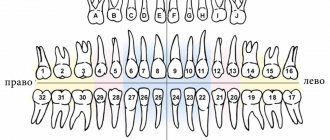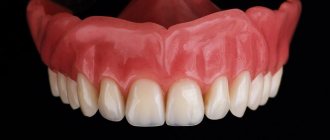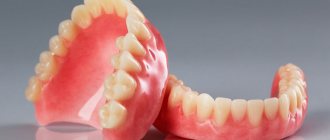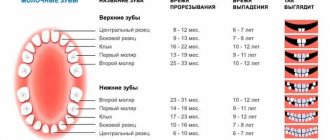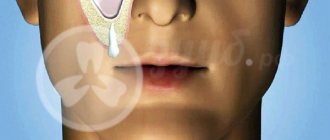To treat or remove a tooth?
Today, dental organizations and doctors are divided into two camps.
The first solve patients' problems in quick and radical ways. These are dentists from public and poorly equipped clinics who cannot provide quality treatment due to a lack of material resources or level of knowledge.
The latter are looking for all sorts of ways to maintain a full bite. They evaluate patients’ problems from the standpoint of “can they be restored or cured,” rather than offering immediate tooth extraction as the only correct solution.
Why are “rescuer” doctors the best option for patients? It's simple. Restoration work:
- guarantee long-term dental health;
- do not force you to think about implants, crowns;
- minimize pain;
- maintain the natural attractiveness of a smile;
- provide the correct bite or restore it.
Frequent concerns of patients on the topic of “treating or removing” a tooth concern:
- enamel cracks;
- fillings that burst along with the crown;
- third “wise” molars;
- resorcinated teeth.
Four problems are the “stumbling blocks” on which the opinions of dentists of the old and new schools differ. The most reasonable way in this case is to go to a well-equipped clinic or get several independent dental consultations.
Only then will the patient find answers to all his questions: is it possible to restore a cracked tooth, whether to remove wisdom teeth and resorbed teeth, or to cure them.
How are zirconium crowns made?
To produce dentures from zirconium dioxide, CAD/CAM technology is used, which is the modeling and manufacturing of products using computer programs.
The entire process from preparation to installation of zirconium crowns consists of several successive stages:
- Taking dental impressions at the dentist's office.
- Creation of a three-dimensional model of the future prosthesis on a computer.
- Designing a 3D model of the crown, and “trying it on” here, in a computer program.
- Sending digital information to a special milling machine, on which the frame of the future prosthesis is machined.
- Applying veneering ceramic mass to the base of the crown if it is used to restore the front tooth.
- Baking the prosthesis to achieve a strong connection between the ceramic layers and the frame.
- Grinding and polishing of finished crowns.
If a zirconium dioxide structure is machined “in full anatomy,” that is, subsequent veneering is not expected, then the milky-white prosthesis is treated with special dyes before final sintering. After this, it takes on a more natural look.
Caries on a wisdom tooth: treat or remove
Many people have known since childhood that “wisdom” molars are an atavistic heritage. Then the information is laid down that these are molars that are unnecessary for a person, and they need to be removed immediately after eruption. Competent dentists today do not support this opinion.
The situation needs to be viewed from two perspectives.
- Should wisdom teeth be removed if they don’t bother me? Definitely no. Especially if the molars are paired - there is both an upper and a lower one, and also in the absence of mobility, caries and even growth in the dentition.
- Hole in wisdom tooth – treat or remove? It's a little more complicated, but there are more reasons to preserve the third molar than to extract it.
No dentist will answer the question “wisdom tooth caries – treat or remove” without examining the patient. The decision to save a molar is accompanied by an objective assessment of many factors. The doctor looks:
- The degree of damage is the number of caries lesions, their location, and the presence of other dental problems. It happens that a patient comes with “caries,” but in reality it turns out that the carious process has already gone far. And here several options are possible - pulpitis, periodontitis, cyst, wisdom tooth granuloma.
- Location under or above the gum tissue - retracted and semi-retracted teeth often bother patients, but it is not difficult to solve this problem with modern medicine.
- Quality of growth. Wisdom teeth do not always grow straight. Sometimes it interferes with chewing, injures the soft tissues of the cheek, and serves as a constant source of discomfort.
Studying all aspects of the disease, painstaking and accurate diagnosis will help the doctor make a decision on treatment and select the optimal sequence of manipulations.
New technologies guarding “wisdom”
The decision has been made - we need to treat. Often such information leads the patient to panic, expecting pain and discomfort. Don't worry. Complete painless treatment is guaranteed by modern equipment and the professionalism of the doctor.
When sanitation of the oral cavity, the dentist uses:
- Modern equipment. Installation with a bur rotation speed of 150, 300, 500 rpm with forced water-air cooling of the tip guarantees the absence of unpleasant vibration, eliminates overheating of the tooth, and almost completely eliminates pain. Allows treatment without anesthesia, but for hypersensitive and panicking patients, pain relief remains a necessity.
- High quality anesthesia. There are many options. The choice depends on the skills and knowledge of the doctor and the equipment of the clinic. You can “freeze” half of the patient’s face for 6-8 hours or deprive the patient of discomfort in the local area for 40-60 minutes, which is necessary for the treatment of wisdom tooth caries. Infiltration anesthesia - intraligamentary and intraseptal - for high-quality “freezing” is used in clinics of a high level of service. Monitoring the professionalism of dentists and their frequent training ensure full mastery of complex anesthesiological techniques.
The use of modern treatment methods makes it possible to get rid of even pulpitis of the third molar. The presence of numerous channels, their arbitrary curvature, and deep damage to the structure are not a problem for innovative technologies. Of course, the doctor will need full control of the process - high-quality x-rays, the use of a dental microscope, an apex locator, and other tools and devices.
The result of the efforts is logical: the quality of the work is excellent, and the patient’s “wise” molar is preserved.
Subsequent stages
The patient's next session awaits a few days later. The doctor removes the dentin bandage and re-does all the manipulations that the affected areas were subjected to during the first procedure. Thus, they are additionally impregnated with resorcinol-formalin mass.
Then the solution used is modified. A specialist adds a catalyst to it on a pre-prepared glass plate. The latter is represented by 3 drops of chloramine, in other cases - 2 drops of sodium hydroxide. The prepared mixture completely seals the affected canal. Its filling with resorcinol-formalin substance is brought to the state of a tight mass. All excess is removed. A phosphate cement liner is then used to cover the orifice. In addition to it, a permanent filling material is fixed to the dental crown, thanks to which the treated cavity is closed.
Cracked tooth: treatment or removal
Cracking of teeth is a common reason for visiting a dental clinic. The category of “mechanical” diagnoses is numerous. These include:
- the appearance of cracks - vertical, horizontal, diagonal, root;
- tooth decay, fillings, crowns.
Damage differs in intensity, location, and difficulty of recovery.
In the past, the fate of cracked teeth was a foregone conclusion. The patient walked with the damaged structure for as long as he could, then went to the surgeon, who used forceps to radically eliminate the damage. Along with the tooth.
Today, the patient does not have to panic when damage appears. It is enough to come to a good doctor with the question of a crack or a broken tooth with a filling - what to do, in order to find out about alternative treatment options. If you have any doubts about your dentist’s recommendations, you should seek independent advice from other clinics. Because – with a high degree of probability – it is possible to save a cracked tooth!
Rescue Cracked Teeth
The complexity of dental procedures determines the scope of work - the location of the damage, the depth of the cracks, the consequences of the injury:
- Removal of surface microcracks. The doctor schedules several visits and sequentially covers the enamel with a medicinal composition with a high content of fluoride and calcium. Gradually, the microcracks are filled and the tooth is restored.
- Darkening of the enamel due to minor local damage. What is required is not a strengthening composition, but veneers. Neat plates will give your teeth an aesthetic appearance and strengthen the enamel.
- Cracks in the tooth surface and resulting chips. They do not require treatment if they do not reach the pulp tissue. The tooth is restored to the desired aesthetics and functionality with extensions or a crown.
- Complex damage that permeates the entire structure is often the cause of inflammatory processes. The tooth is restored sequentially - through depulpation, disinfection, crown.
- The tooth is split, part of it is loose. Until recently, such objects were immediately subject to removal. And today many public clinics do not offer alternatives. In fact, the tooth can be saved. The doctor will formulate the principles of treatment after viewing the x-ray, since it is important to see the surviving root base. If there is a root, after removing the moving part, the missing section is built up onto the pin. If the pin cannot be placed, the structure is restored with a photopolymer filling and the tooth is covered with a crown.
- Crack at the root. Why root cracks occur in a living tooth, let the diagnosticians deal with this; for the patient, it is important to save the damaged object. It's real. Examining the dental structure using a dental microscope will show how far the process has progressed. If the breakage concerns only part of the root and the tooth is not damaged, endodontic surgery can be used to remove the broken area and save the rest.
There are no uniform algorithms in dentistry. Each diagnosis requires separate study and selection of treatment. And the better the equipment of the clinic, the higher the professionalism of the doctors, the greater the likelihood that the patient will save his teeth and return them to their original health.
Who is suitable for zirconium crowns?
In each case, different materials may be suitable for prosthetics. So, if we consider zirconium crowns, then these reliable and aesthetic prostheses are suitable for restoring teeth in any part of the row, including chewing units. They are also suitable for installation in the smile area. To achieve the effect of a natural tooth, crowns that replace incisors are covered with a porcelain layer and painted in the color of natural enamel.
Indications for the use of zirconium dioxide prostheses may also include a patient’s tendency to be allergic to metal, loose gums, and increased tooth wear. Another argument for this particular choice is the desire to keep the abutment tooth alive and minimally ground. This is not possible when using metal-ceramic structures.
Should resorcinated teeth be removed?
Patients of Soviet dentistries are aware of what resorcinol fillings are. Beginning in 1912 and for almost 100 years, caries was resorcinolized - eliminated using the resorcinol-formalin filling method. At the same time, the dentists did not inform the patients that subsequently the teeth turn yellow, decay, become increasingly fragile, and cannot be refilled.
Times have changed, and seemingly harmful fillings can be replaced with modern filling compounds. However, this turned out to be practically impossible - it is impossible to clean the channels from the resorcinol-formalin mixture. During the hardening process, the filling acquires the density of glass and is soldered to the walls of the root canal. The verdict of most doctors when dealing with resorcinated teeth is the same - removal.
But there is no need to rush in this case either. Today, modern dental equipment allows you to drill out and remove even the strongest glassy material and bring the tooth into excellent condition. Yes, not all clinics have the necessary equipment, but it is there. And finding “your” doctor after several consultations will completely solve this problem.
Resorcinol-formalin method: preparatory stage
The essence of this method is to transform the pulp into a plastic-like aseptic strand, which would not be subject to dissolution under the influence of tissue microflora. Therefore, in order to avoid the development of “residual pulpitis,” the pulp must be devitalized before impregnation begins.
Filling canals using Albrecht technology is carried out in several stages. At the preparatory stage, attention is paid to filling the root canals, which were managed to pass along the entire length. Others are filled in to the extent possible. Then, to necrotize the tissue remnants of the damaged pulp, the mouths of each of them are drilled out. Three sessions are allotted for all manipulations.
At this stage, the specialist is preparing the solution. Start making a paste with 5 drops of formaldehyde, for which a glass plate is used. Afterwards, resorcinol is gradually added to it. Thorough stirring ensures its complete absorption by formaldehyde.
During impregnation, the patient must be placed in the dental chair in a position that would allow the impregnation solution to flow into the canal under the influence of gravity. Filling the teeth of the lower jaw requires an even fit, while a lying position with the head tilted back will be required in the case of treatment of teeth in the upper jaw.
Life time
Crowns and bridges made of zirconium dioxide last the longest of all similar structures. This material is 30 times stronger than ceramics, so dentures made from it can last 15–20 years, and this period is not the limit either. But to extend the period of use of such crowns, you need to properly care for them and not test their strength by cracking nuts or candy with your teeth. In addition, it is important to regularly visit the dentist for preventive examinations and check the condition of the supporting units, which also determines the service life of the dentures installed on them.

